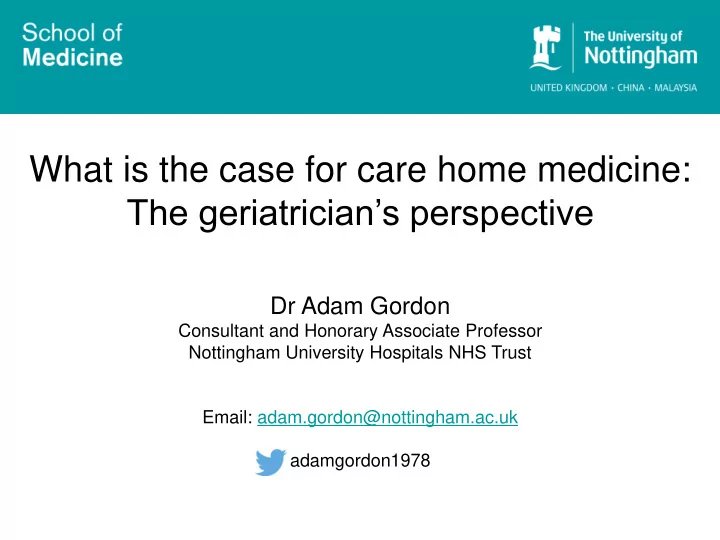

What is the case for care home medicine: The geriatrician’s perspective Dr Adam Gordon Consultant and Honorary Associate Professor Nottingham University Hospitals NHS Trust Email: adam.gordon@nottingham.ac.uk adamgordon1978
HEALTH WARNING: Generalizable concepts will be presented. They will sometimes be viewed through an English prism.
Care Homes • Who lives in them? • What do they need? • How is care currently provided and does it meet their needs? • Challenges unique to the care home setting. • Some ways forward.
In the Care Home Outcome study…. The proportion of care home residents with cognitive impairment was: • 0-25% • 26-50% • 51-75% • 76-100%
In the Care Home Outcome study…. The proportion of care home residents with urinary incontinence was: • 0-25% • 26-50% • 51-75% • 76-100%
In the Care Home Outcome study…. The proportion of care home residents who were bed- or chair-bound was: • 0-25% • 26-50% • 51-75% • 76-100%
Some other headline figures…. • Average number of diagnoses – 6.2 • Median number of medications – 8 • 2/3 had some form of behavioural symptom • 30% malnourished • 56% at risk of malnutrition • Average life expectancy – 1 year for nursing homes – 2 years for residential homes
Effective healthcare responses will…. • Have expertise in management of: – Multiple diagnoses – Immobility – Incontinence – Challenging behaviour – Polypharmacy – Malnutrition – End-of-life care
Physical Mental/Psycholo gical CGA Functional Social Environmental
Assessment Stratified Goals problem list Bespoke Management Plan
What currently happens GP’s deliver care as part of GMS….although sometimes they don’t(!) GP:care home ratios vary 1:1-1:50 Reactive care models predominate Multidisciplinary team access is limited Roles and responsibilities aren’t clearly specified
Common problems Older people are very complicated. Trajectories are difficult to predict. Don’t have the training. Resources are tight. Regulation is always present. Roles and responsibilities aren’t clear. Communication is a problem.
Solutions have focused around… Remuneration – carrot. Regulation – stick. Parachuting in troops. Generating social movements.
Be careful what you wish for…. 1:1 relationship “I wouldn’t wish Trusting our GP/care relationship with home on my mutual respect worst enemy”
Similar issues face Open ended “social movement” models. Incentivisation with accountability (too much carrot not enough stick). Expertise without appropriate linkages. Inadequate remuneration (too much stick, not enough carrot).
Physical Mental/Psycholo gical CGA Functional Social Environmental
Assessment Stratified Goals problem list Bespoke Management Plan
Care Homes • Present some particular challenges. • Which demand particular solutions. • And particular knowledge and skills. • So there probably is such a thing as “care home medicine” • But it is a concept in evolution – watch this space….
Recommend
More recommend